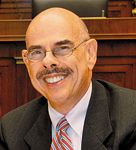Waxman: 12-year wait for biosimilars too long
Implementation of the "biosimilars" law is going well, but the exclusivity period seems to be a problem.

Henry Waxman (D-Calif) told a recent generics industry conference, "I believe the biosimilar provisions of the Affordable Care Act unfortunately fell far short of assuring that innovation will be balanced with competition. As a result, the generic medicines market will, I fear, not expand in the area of biologics in as robust a manner as should be possible, no matter how well the FDA implements its biosimilars program."
The wait for biosimilars
Neither he nor President Obama has given up on the effort to shorten the period, Waxman promised, noting that the President called for cutting the exclusivity period for innovator biologics to 7 years in his deficit reduction package.
"The proposal would result in a 3.5 billion dollars in savings over the 10 years to the federal health programs, including Medicare and Medicaid," Waxman told several dozen attendees at the World Generic Medicines Congress, Americas, meeting in Washington, D.C.
More solutions needed
Waxman, currently the ranking member (top minority member) of the powerful House Energy and Commerce Committee, chaired that committee from 2009 to 2010, when Democrats controlled the House and the healthcare reform law relating to the biosimilar pathway passed. He also coauthored the 1984 "Hatch-Waxman" Act, which allowed generic drugs to come on the market more easily.
Waxman also said that he and President Obama continue to oppose the provision in the law that allows "evergreening"; that is, permitting innovators to obtain repeated 12-year terms of exclusivity for new versions of a biologic. "This was a success for the lobby efforts of BIO [the lobbying group for the biotechnology industry] and PhRMA [Pharmaceutical Research and Manufacturers of America]. And I'm sorry they got that provision in there."
He added that he hopes the nation will come up with further solutions to drug shortages, noting that FDA says the majority of drugs in short supply are generic sterile injectables. Work needs to go beyond President Obama's recent executive order increasing federal action and the proposed bills in Congress to require companies to give advance notice when they discontinue or interrupt production of a prescription drug, he said.
Looking forward

Boothe pointed out that under the healthcare reform law, there is potential for 40 million new individuals to obtain insurance coverage, and he cited estimates that pharmaceutical spending will almost double by 2020. Beyond that, he noted, will be increased pressure to use generics as healthcare costs continue to rise.
For example, said Boothe, people with some types of insurance, who pay co-pays of perhaps $1 or $2 for a generic and $2 for a brand drug, may see a greater difference between the 2 prices as healthcare costs continue to squeeze states and other parties.
Boothe also predicted that brand-name companies will continue to come up with new treatments, helping to fill the long-term pipeline for generics.
In January FDA recommended to Congress user-fee programs for generics and biosimilars, to help speed drugs to market.
The hope of manufacturers is that in return for user fees, the current review cycle of 26 to 30 months or longer would be scaled back to 10 to 18 months, Boothe noted.
He also predicted the movement of the market into more innovative generics, including suspensions, ointments, gels, prefilled applications, hormones, sterile optics, nasal sprays, and even such products as respiratory devices and implants.
Along with development of those products, he predicted, will come increasing regulatory and marketing complexity.
How PBMs Impede Pharmacists’ Ability to Perform Clinical Services | APhA 2025
March 31st 2025Antonio Ciaccia, President of 3 Axis Advisors, led a discussion on pharmacy benefit manager reform and how the inability to pass legislation has led to increased financial hardships in community pharmacy.